The purpose of this article is to highlight the necessity of keeping the investment portfolio well diversified. We’ll see in this blog post how investment diversification is not only about buying different types of assets, it is more about keeping a balanced portfolio. For quick answers on the diversification strategy, check the FAQs
Introduction
What is investment diversification? Including different types of non-related assets in a portfolio is diversification. It is a strategy to minimize the risk of loss in case of unpleasant market movements.
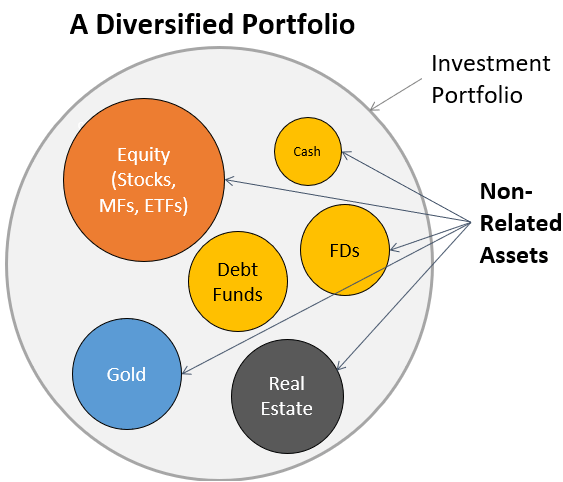
Example: Suppose you bought an Index ETF in the past for Rs.50,000. As of today, the price of the ETF is down 5%. In the same period, you also bought a gold ETF of Rs.50,000. The price of gold is up by 8.5%. The net effect is that your portfolio is up by 3.5%. Even if the equity (ETF) was down by 5%, this loss was compensated by 8.5% gains by Gold ETF. This is an example of a diversified portfolio that has two unrelated assets (equity and gold).
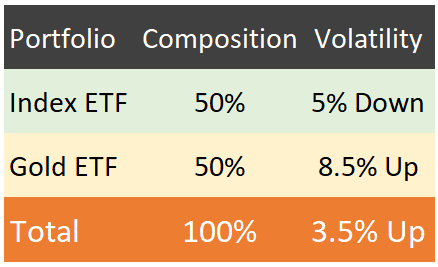
Video [Hindi]
When to Diversify Investments?
In the above example, uncle Sam might say, had you invested only in gold ETF, your gain would have been 8.5% instead of 3.5%. Uncle is not wrong, but at the point of investing, you did not know that the ETF will perform badly than gold or vice versa. So, what is the lesson?
When we are unsure of the future performance of the assets we are investing in, it’s better to spread the money into different, non-related, assets. This strategy must be used especially by retail investors who cannot analyze their investments more deeply.
What are unsure investments? Those investments where sufficient self-research has not been done by the investor. There can be two main reasons why people do not research before buying investments: (a) due to lack of know-how and/or (b) lack of time. If one is falling into either of these two categories, it is a hint that an investment diversification strategy is necessary for him/her.
The Strategy of Investment Diversification
An investment portfolio must at least have two non-related assets. If you are an aggressive investor you would like your portfolio to be equity-heavy. The portfolio composition of a typical aggressive investor may look as shown in the below infographics. Please note the change in the portfolio composition with the market’s valuation.
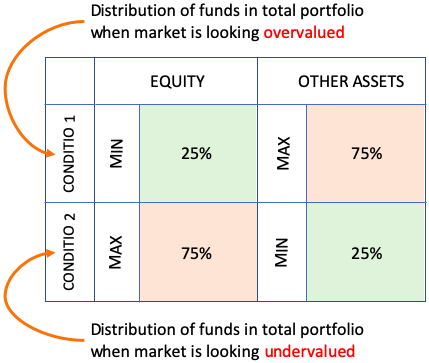
Few takeaways:
- Equity Weight: In all types of market conditions, an investor’s portfolio should not have 100% equity. With the change in the market’s valuations, the equity weight of the portfolio can change from 75% (undervalued) to 25% (overvalued).
- Overvalued Market: At a time when the index is touching all-time highs, the weight of equity should be minimum. This is not a time to buy equity. It is a time to sell & book profits (if necessary).
- Undervalued Market: When the index is bleeding, it is time to buy equity. It is not the time to sell stocks and mutual funds. It is the moment when the equity weight should be maximum. It is the time to sell other assets and buy equity (if necessary).
- Other Assets: When the weight of equity will reduce in the portfolio, the weight of other assets will increase and vice versa. Its relationship with equity is inversely proportional. Other asset types can be real estate, gold, debt instruments, etc. Read: How to build assets.
This process of altering the composition of a portfolio based on the market’s valuation is called portfolio balancing. So what we can conclude from this learning? Investment diversification is a dynamic activity. As important as it is to include different asset classes in the portfolio, it is equally important to change the weight of asset types depending on the market conditions.
Preconditions to build a diversified portfolio
Before a retail investor can diversify their investment portfolio, they must know a few basics.
- Asset Types: To make an investment portfolio diversified, it is essential to include equity, real estate, gold, and debt-based instruments. Within equity, stocks, multi-cap mutual funds, and index funds shall be included. One can add REITs to include real estate in the portfolio. Physical gold or gold ETFs can be purchased. Debt instruments can be in the form of deposits or debt mutual funds.
- Composition of Assets: A diversified portfolio must include the above four asset types in specific proportions. But the weight of each asset in the portfolio should change if the market conditions change. Read more about how to judge market conditions and the concept of portfolio balancing.
- Type of Investor: The composition of assets in a portfolio will change from investor to investor. Generally speaking, all investors can be classified into three broad types. The three types are defensive, moderate, and aggressive. The three investor types are classified based on their risk appetite. The defensive investor’s risk appetite is minimum and its maximum for the aggressive investor. The majority of retail investors are neither aggressive nor defensive, they are moderate in nature.
How to Diversify?
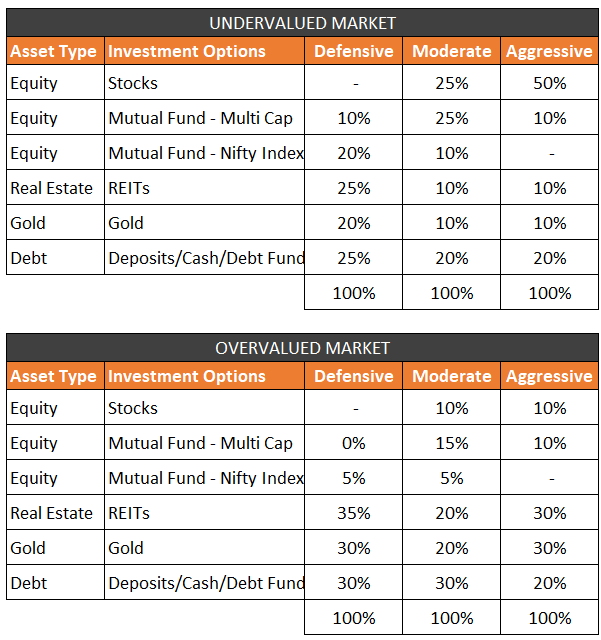
Investment portfolio diversification is a dynamic activity. The above two tables show the composition of assets in two extreme market conditions, undervaluation, and overvaluation. The task of diversification is to keep the weight of assets within the limits as the market fluctuates between the two extremes. This is called portfolio balancing.
[P.Note: I’ve indicated the above weights based on my investment personality, knowledge, and financial health. It is necessary to only refer to these numbers as a reference. One must judge their own conditions and change the percentage numbers as per their liking and comfort]
The Concept of Portfolio Balancing
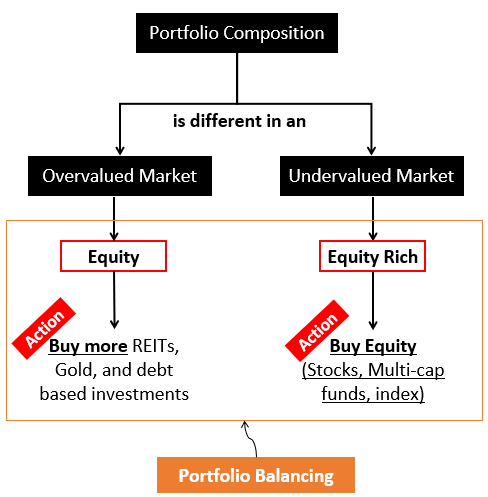
The concept of portfolio balancing states that in an overvalued market buy more non-equity assets like REITs, gold, and debt instruments. In an undervalued market focus shall be on equity purchase.
Is it necessary to sell equity in an overvalued market? No. I personally hold only specific stocks and mutual funds in my investment portfolio. I’ve accumulated them over time whenever I found them available at undervalued price levels. Selling such assets just because the Nifty/Sensex is at their peaks is not necessary.
So what do I do to alter the composition of assets when the market conditions change?
When non-equity assets are purchased, the weight of equity in the portfolio automatically falls. It is not necessary to sell equity to lower its weight in the portfolio. For sure, if the investor considers a particular equity (like a stock) to be overvalued, it can be sold. The proceeds of such a sale can then be used to buy non-equity assets.
What to do when the market is neither undervalued nor overvalued?
This is a typical situation when the investor is unsure about the market. In such times it is better to assume the market as if it is overvalued. Hence the money must flow to non-equity assets like real estate, gold, debt, etc.
Unsure investors can also consider investing in an index through ETFs or index funds. Beginners should avoid the purchase of individual stocks or equity fund units when they are unsure about the market position.
Assets & Investment Diversification
Asset: Equity
- Direct Stocks: In a bullish market, buying stocks will be risky for retail investors. Though it is also true, value stocks are available in all types of market conditions. But as most stocks are overvalued when the market is at its peak, the chances of a mistaken purchase are too high. When the market is falling or nearing its bottom, targeting blue chip stocks is a safe strategy. In such times, quality mid-caps and small-cap stocks can render faster capital appreciation.
- Multi-cap Mutual Funds: People who are not comfortable with direct stocks, can invest in multi-cap mutual funds. As the portfolio of mutual funds consists of a basket of stocks, they are inherently more diversified. Hence are safer than stocks.
- Index ETFs: People who want the best of both worlds, stocks and mutual funds, can consider index ETFs. It can be traded like stocks and has a diversified portfolio like a mutual fund.
Other Assets
- Real Estate: A real estate property provides good diversification for an equity-based portfolio. The equity market has a negligible correlation with real estate. The ideal investment option will be residential or commercial property. If one does not have large capital available for investment, REITs can be a good investment option in the real estate sector.
- Gold: There are two main ways of investing in gold, physical or through ETFs. Both options are equally good. But before investing in gold, it must be kept in mind that holding time should be more than 10 years. Why? Because in this time horizon, gold price appreciation is decent. Read about the other ways to invest in gold.
- Debt-Based: There are several types of debt-based instruments available for investment. The most preferable one is debt mutual funds. Staying invested in debt funds for a long time horizon like 10 years can fetch about 8-9% per annum returns. Bank deposits are other safer forms of debt instruments but their yield is lower and are also less tax efficient. Till no other alternatives come to mind, I prefer keeping my cash parked in a liquid mutual fund.
Summary
Investment diversification is not only about the accumulation of non-related assets in the portfolio. The real challenge is portfolio balancing. Why a diversified portfolio is necessary? To minimize the risk of loss. To do it, we cannot afford to keep the weight of assets constant. It must change as the situation demands.
When the equity market is overvalued, other asset classes will be trading at bargain prices. Hence, in such times, an investor should avoid equity and buy REITs, gold, debt funds, etc. If not, at least keep the cash. But avoid equity investing.
When the equity market is undervalued, buying stocks, multip-cap funds, and index ETFs will earn high returns. Hence, in such times the investment is more straightforward.
Building an investment portfolio with this thought process will automatically make a portfolio diversified.
A Guide: How To Judge Market Conditions?
How to judge if the market is over or undervalued? Here are a few general indicators:
Overvalued Market: In this type of market, the GDP growth rate and inflation have already peaked. This means, moving forward they will show a falling trend. The prevailing interest rate is at its bottom levels. It means the rising trend is about to start. The main indices like the Nifty and Sensex are near their all-time highs. Individual stock’s PE and PB levels will also be at their highs. All this is happening because there is excess liquidity in the economy.
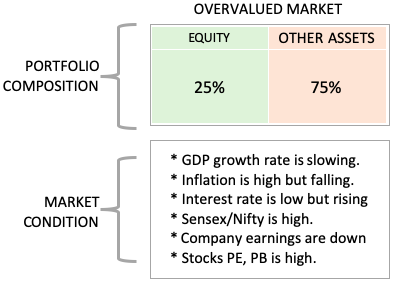
Undervalued Market: The general indicators as described above will be reversed in an undervalued market. The government is less worried about inflation and more about how to boost consumption in the economy. They are ready to lower the interest rates. The news channels will host discussions about how to increase the GDP growth rate. Nifty and Sensex would have been trading flat or down by 10-15% from their peaks.
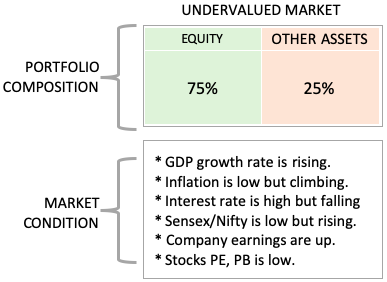
Transition Phase: Here the market is neither at its peak nor at the bottom. Most of the time the market can be found in this position. In such times, all indicators like inflation, interest rates, indices, and stock valuations will be trading flat. Flat market indicators are a hint that the valuation is soon going to turn its tides. They may correct before seeing another bull run.
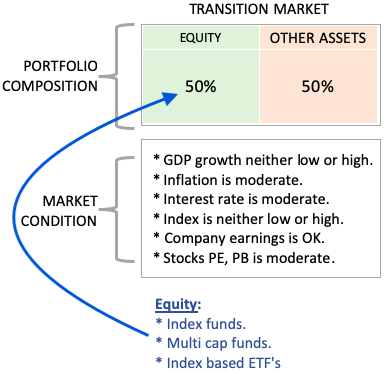
FAQs
An investment portfolio that contains a mix of non-related assets like equity, gold ETF, REITs, and debt funds can be considered diversified. Within the equity portfolio, including stocks of different sectors can further enhance diversification. Check a simple example here.
The simplest and best way is to spread the money between rental properties, multi-cap funds, physical gold, and debt mutual fund. An informed investor can put 60% into equity, and the balance can be spread between real estate, gold, and debt funds. If the size of the portfolio is small, the physical property can be replaced with REITs. Similarly, gold ETF can replace physical gold.
A diversified investment portfolio is more resistant to downside movements. A negative movement in one type of asset is offset by a positive movement in another asset. Hence, in all types of market conditions, a diversified portfolio remains more stable than a non-diversified portfolio. Furthermore, as investors are dealing with multiple asset types, their investment personality and outlook become more mature. Generally speaking, such people can take better investment decisions.
Warren Buffett considers diversification as a tool that can preserve wealth. But he also thinks that, if one has to build substantial wealth over time, a concentrated portfolio will be better. For a retail investor, a concentrated portfolio is risky as it may include bad-quality assets as well. The inclusion of bad-quality assets can substantially harm the overall value of the portfolio. Hence, for retail investors, who do not know a lot about investment analysis, a diversified portfolio is preferable. Read more about when to diversify.
Limiting the weight of different asset types in a portfolio makes a balanced portfolio. But a balanced portfolio of today may become unbalanced in times to come. It happens as the value of a few assets inflates and some deflate. To maintain the balance, sell overvalued assets and use the proceeds to buy other assets which look undervalued. Know more about the concept of portfolio balancing.
I hope you liked reading this article. Please leave your views in the comment section below.
Have a happy investing.

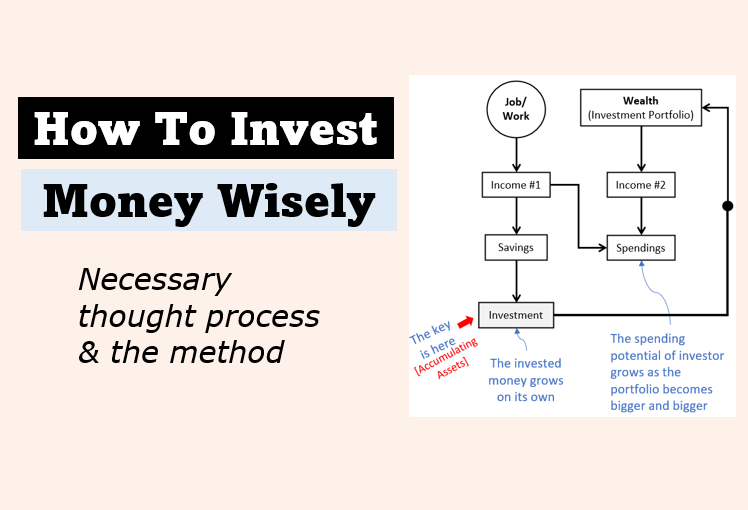

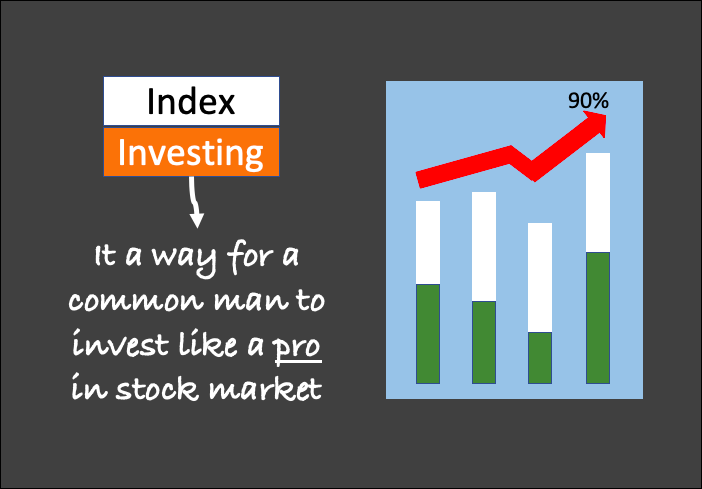
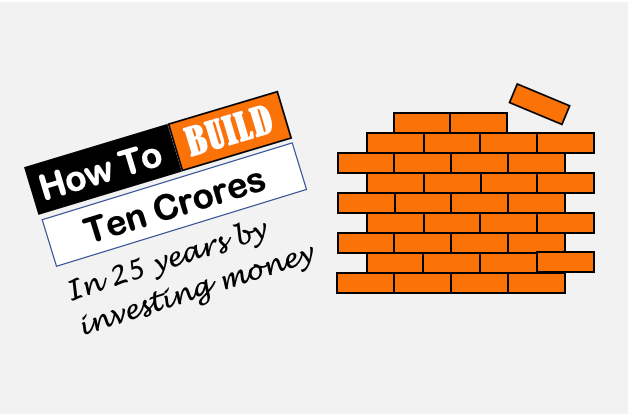
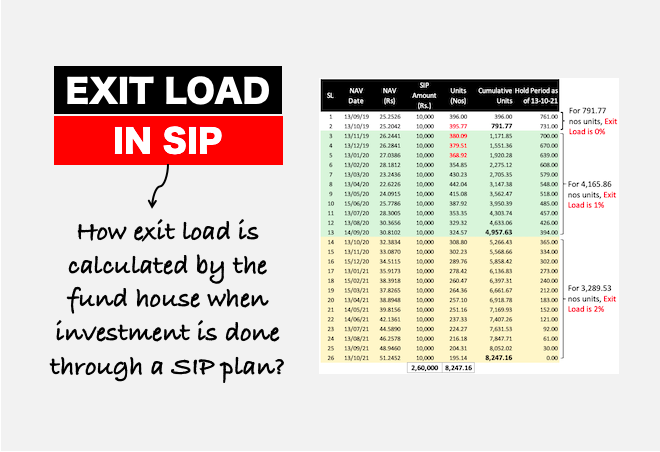
Diversification is always a smart choice, whether it is diversification of business, investment or earnings. A diversified portfolio minimises risks while investing for the long-term. One should always minimise the unpredictability of stock transactions by applying qualitative risk analysis before buying or selling a stock
Thank you for writing this article. I am a beginner and you broke down the concepts fairly well. It gives me a foundation to learn further.
Thanks
wow, This article is so detailed !. Usually, people just put on their thoughts on diversification but you have explained it well sir :).
Thank you for the article
Hi Mani, Very nice and interesting post. I also believe along with diversification, proper capital allocation in same class is also very important. There are very articles or people talk on this. Can you look over this topic and write your thoughts on. I came across Kelly criterion for value investors.. Thankyou for all your posts.. keep writing and sharing knowledge.
Investment is very important and to invest your money you need to start saving your money at an early age. Diversification is definitely an effective way to reduce the risk of loss. Investing all your money in one type of asset can be risky and cause a major loss whereas in diversification the risk of losses is much less.
Great article but I am not a fan of diversification, and great companies are too not, like google developed the best search engine and monetized it, so did microsoft with windows, Apple with iPhone etc, and these companies are multibaggers. If I had picked any of these companies early, I would of held it for very long time and would have not diversified!.
Diversification is a free tool which people can choose to use depending on their preference.
Such a good information about investing in stock market. Thank you
It is a great article in the right time and cautioned about stock market correction and stay away from peak market which may correct at any time is a good advice . Thanks a lot
Thanks for posting your views.
You have put really good information….It will helpful for me..Thank you!